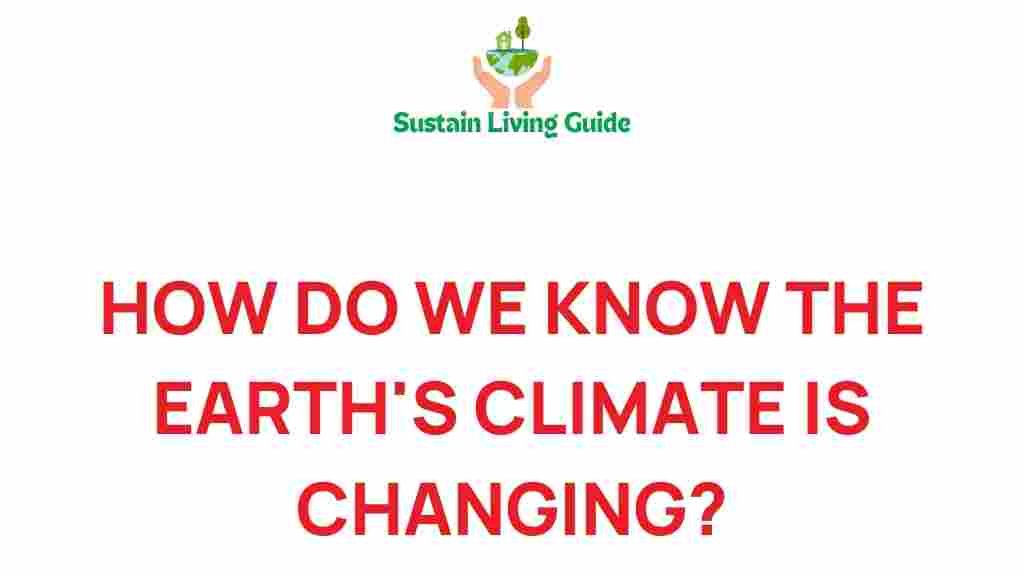Climate Change: Understanding the Evidence Behind Earth’s Changing Climate
Climate change has become a defining issue of our time, impacting ecosystems, weather patterns, and human livelihoods across the globe. While many acknowledge that climate change exists, the question remains: how do we know the Earth’s climate is changing? This article aims to unveil the truth behind climate change, exploring the evidence that supports its reality and addressing common misconceptions.
The Science of Climate Change
To understand how we know the Earth’s climate is changing, it is essential to explore the science behind climate change. Scientists utilize a variety of methods and data sources to monitor and analyze climate patterns. Here are some key indicators:
- Temperature Records: Historical temperature data collected from weather stations worldwide show a clear upward trend in global temperatures over the past century.
- Ice Core Samples: Ice cores drilled from glaciers provide valuable information about past climates, revealing atmospheric gas concentrations over hundreds of thousands of years.
- Satellite Observations: Satellites monitor Earth’s surface temperatures, ice cover, and vegetation changes, providing real-time data on climate changes.
- Ocean Temperature Measurements: The oceans absorb much of the excess heat from climate change, and their rising temperatures are a strong indicator of a warming planet.
Temperature Records: A Clear Trend
Temperature records are one of the most straightforward indicators of climate change. The National Centers for Environmental Information (NCEI) provides data showing that the global average temperature has risen significantly since the late 19th century, primarily due to human activities such as burning fossil fuels.
Ice Core Samples: A Window into the Past
Ice core samples from places like Antarctica and Greenland contain bubbles of ancient air, which allow scientists to measure historical greenhouse gas concentrations. By studying these samples, researchers can correlate past temperature changes with carbon dioxide levels, demonstrating a clear link between the two.
Satellite Observations: Monitoring Change from Space
Satellites play a crucial role in climate science by offering a comprehensive view of the Earth’s atmosphere and surface. They help scientists track changes in:
- Glacier and ice sheet mass
- Sea-level rise
- Vegetation cover
Data from satellites have shown significant declines in Arctic sea ice and rising sea levels, further supporting the reality of climate change.
Step-by-Step Evidence of Climate Change
The evidence for climate change can be broken down into several key steps:
Step 1: Recognizing the Rising Temperatures
The first step involves acknowledging the data collected over the years. According to reports from the Intergovernmental Panel on Climate Change (IPCC), global temperatures have increased by approximately 1.1 degrees Celsius since the late 19th century. This trend illustrates the gradual warming of the planet.
Step 2: Examining Extreme Weather Events
As temperatures rise, we also witness an increase in the frequency and intensity of extreme weather events. These include:
- Heatwaves
- Heavy rainfall and flooding
- Hurricanes and typhoons
Studies indicate a direct correlation between climate change and these extreme weather patterns, suggesting that a warmer atmosphere can hold more moisture and contribute to severe weather events.
Step 3: Observing Sea-Level Rise
Sea levels have risen due to two main factors:
- Thermal expansion of seawater as it warms
- Melting ice sheets and glaciers
According to the IPCC, global mean sea levels have risen by about 20 centimeters since the late 19th century, threatening coastal communities and ecosystems.
Step 4: Analyzing Changes in Ecosystems
Climate change also affects ecosystems, leading to shifts in species distributions, altered migration patterns, and changes in breeding seasons. Scientists observe these changes through:
- Species population studies
- Phenological records (timing of natural events)
For instance, some bird species are now migrating earlier due to warmer spring temperatures, which can disrupt their feeding and breeding habits.
Troubleshooting Common Misconceptions About Climate Change
Despite the overwhelming evidence supporting climate change, several misconceptions persist. Here are some common ones and their clarifications:
Misconception 1: Climate Change is a Natural Process
While natural factors do influence the climate, the rapid changes we are witnessing today are largely driven by human activities, particularly the burning of fossil fuels. The current rate of change is much faster than any natural variability observed in the past.
Misconception 2: Weather and Climate are the Same
Weather refers to short-term atmospheric conditions, while climate represents long-term averages over decades or centuries. An extremely cold winter does not negate the long-term trend of global warming.
Misconception 3: Climate Change is Not Happening Everywhere
Climate change may manifest differently in various parts of the world, but it affects everyone. Some regions may experience droughts, while others face increased rainfall and flooding. These localized effects contribute to the global picture of climate change.
Conclusion: The Urgency of Addressing Climate Change
The evidence is clear: climate change is real, and it is happening now. From rising temperatures and sea levels to extreme weather events and ecological disruptions, the signs are undeniable. Addressing climate change requires global collaboration and immediate action. Understanding how we know the Earth’s climate is changing is a crucial step in motivating individuals, communities, and governments to act.
By acknowledging the scientific evidence and dispelling common myths, we can foster a more informed dialogue about climate change. It is our collective responsibility to take action to mitigate its impacts and protect our planet for future generations.
For more information on how to get involved and make a difference, visit this resource.
This article is in the category Greenhouse and created by SustainLivingGuide Team
